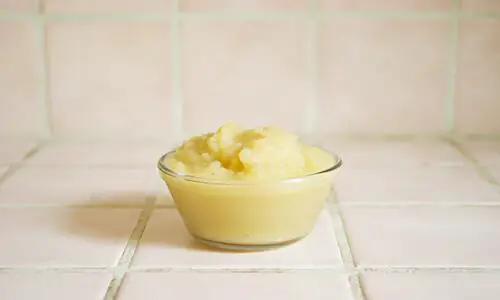Applesauce makes for a healthy, nutritional snack…well, unless mold grows on it. If you just see mold on the surface of a jar or container of applesauce, can you still eat this fruity treat, or do you have to throw it away?
Once mold has been discovered on applesauce, it should be discarded as it is not safe to eat. The most commonly found mold growing on apple sauce is Penicillium expansum, which can cause serious health complaints in those with weaker immune systems when ingested, or the spores inhaled.
In today’s guide, we’ll discuss what causes applesauce to develop mold, how to identify mold on applesauce, and what happens if you ingest it. If you keep applesauce in your pantry, you won’t want to miss this!

Why Does Applesauce Grow Mold?
What causes applesauce to develop mold? There are two chief causes, so let’s examine them now.
Too Much Sugar
Mold appreciates a dark, moist environment, but what the fungi also appreciates is sugar. It doesn’t matter what kind of sugar; mold will eat it and grow. The higher the sugar content a product has, the greater the propensity for mold.
Most people sweeten homemade applesauce with a spoonful (or several) of sugar. If the mold gets the opportunity to reach the jar of applesauce (more on how it does this in just a moment), the fungi will feast on the sugar in the applesauce.
Before you know it, you’ll see mold on the surface of your fruity treat.
Mold in the Air
Unless you filter the air with a purifier, mold could exist in the air you breathe.
These mold spores don’t pose a problem to the average person, although the same cannot be said for those with mold allergies or other breathing issues such as asthma.
You won’t even know the mold spores are in the air, but they are. The spores can eventually settle on the surface of open applesauce, leading to a serious mold problem.
What Kind of Mold Grows on Applesauce?
Mold on applesauce is frequently attributed to the mold strain Penicillium expansum, a common mold strain in pears and apples.
Penicillium expansum is a mycotoxin, a type of fungal toxin that grows on a variety of foods, including coffee beans, apples, dried fruit, spices, nuts, and cereals.
Mycotoxins are serious, as they can contribute to severe illnesses. Besides Penicillium expansum, other fungal strains, such as Penicillium solitum and Botrytis cinerea may also affect apples, although the former is more common in pears than apples.
What Does Mold on Applesauce Look Like?
Do you suspect you might have mold on your applesauce? Usually, it’s not too difficult to confirm a case of fungal spread.
While it depends on the fungus that caused the mold, moldy applesauce will often have a grayish color. Since most applesauce is pale amber, the gray mold might look blueish or greenish.
What if you have a darker red or pinkish applesauce? The gray mold spores can hide better against the darker applesauce, so you’ll have to look at the texture as a second confirmation.
Mold that has grown for a while will have a fuzzy texture. The mold might appear across the entire top surface of the applesauce or only in spots and speckles.
The presence of mold is only one sign of several that applesauce has gone bad. If the applesauce has a foul odor or strange texture, those are also indicative that the fruit has spoiled.
How to Prevent Mold on Applesauce
Mold on applesauce can be extremely frustrating. If you took the time to make applesauce from scratch, you can feel like all your time and hard work were wasted. If you bought your applesauce from the grocery store, you’ll have wasted your money.
Fortunately, you can take proactive measures to prevent the spread of mold on applesauce. Here’s what to do.
Reduce Sugars
You don’t have to completely eliminate sugar from your applesauce, as then it can taste a little bland. However, instead of pouring in several heaping helpings of sugar, consider cutting down the amount you use.
You can reduce the sugar by even a quarter, which should make a difference. Of course, if you can halve how much sugar you use, that’s even better!
Sanitize Your Jars
Even if you’ve never had an issue with moldy applesauce before, you should still sanitize your jars each time you make homemade applesauce. If you have had trouble with mold in the past, this goes double for you.
To sanitize jars, remove the cap or lid and place them in your boiling-water canner rack right side up. Pour hot water into the jars and the canner.
When you’re done purifying the jars and canner, let the water cool and then drain it. Do this every time you use jars for homemade (or store-bought) applesauce.
Use an Air Purifier
Going back to our point from before, mold is in the air all around us. You’re usually breathing in only small amounts of the stuff, but that’s all it takes to settle on applesauce and ruin your latest homemade batch.
An air purifier can reduce toxins in the air such as mold. Consider using one, and you might have less of a mold issue when enjoying applesauce in the future!
Store Applesauce in an Airtight Container
How you store your applesauce matters a lot in keeping it mold-free.
Always keep homemade applesauce in an airtight container such as a jar. Seal the lid on tight, and don’t open the jar more often than necessary. Exposure to air can cause mold.
If you like your applesauce from the grocery store, leave it sealed in its original packaging until you want to eat it.
Unopened applesauce doesn’t require refrigeration, but once you open the treat, you do need to keep it in the fridge to prevent spoilage.
Can You Still Eat Moldy Applesauce?
You only see some mold on the surface of your applesauce. Can you scrape the mold off the top and enjoy the fruity snack you worked so hard to make?
You could, but you shouldn’t, as you could get ill. Remember, the mold that affects apples could contain mycotoxins, and those are potentially deadly.
Just because you remove surface-level mold from applesauce doesn’t mean it’s not lingering deeper in the jar or container.
If you ingest moldy applesauce, you may experience unpleasant symptoms such as nausea, diarrhea, and vomiting. The symptom severity shouldn’t be much, and most of the symptoms should pass in a day or less.
Even still, you risk becoming dehydrated after losing so many fluids. Make sure you replenish the lost fluids with Pedialyte or a sports drink, as water alone doesn’t contain the electrolytes you need.
However, in more serious cases, you could experience prolonged illness. You should see your doctor if you’re still not feeling better a few days after the ingestion of moldy applesauce.
If you have a mold allergy, you should never eat moldy or potentially moldy foods. You could experience anaphylaxis, a life-threatening allergic reaction.
Conclusion
Mold on applesauce occurs as the mold in the air settles on the surface of the fruity snack. The sugars in applesauce are also very appealing to mold.
Please, do not eat moldy applesauce. At the very least, it can cause illness, and at worst, the mycotoxins could lead to health complications and possibly even death. Throw the applesauce away and start from scratch or buy a new jar. It’s the smart choice for your health!

